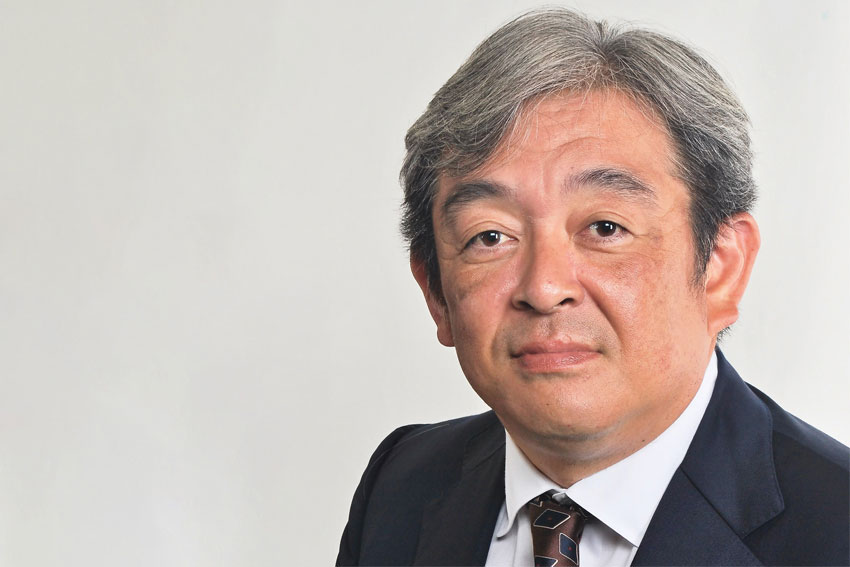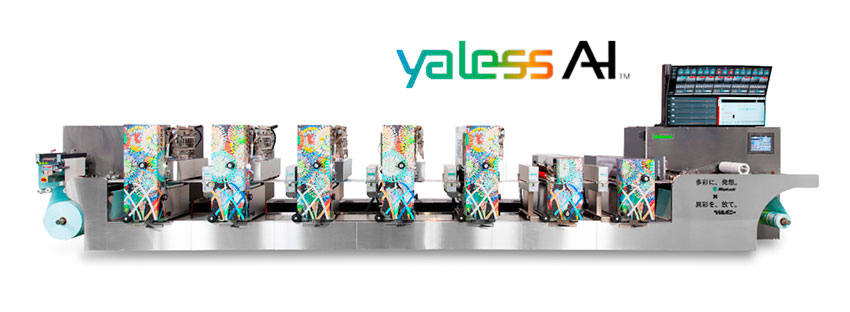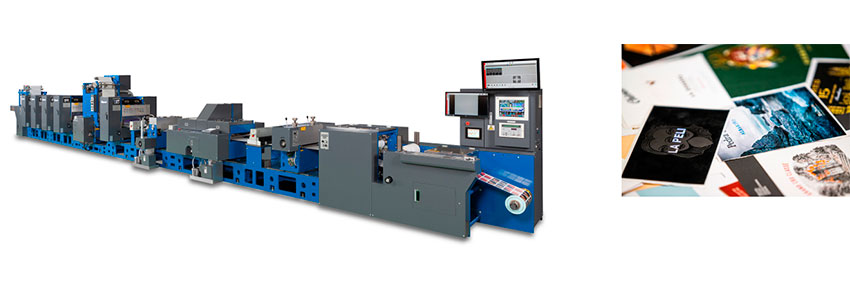Providing digital print solutions for flexible packaging is Miyakoshi Printing’s specialty and the Chiba-headquartered firm has made inroads into the European packaging market.

Monozukuri is Japan’s most famous manufacturing philosophy. Historically, as it applies to printing, Japan copied books by hand dating back to the Edo period (17-mid-18th century). When the Gutenberg press was introduced, Japan was the first nation in Asia to adopt the technology. Today, your company specializes in machinery for printing and post-printing processes. Could you give us your opinion on modern monozukuri, especially as it relates to your business?
Since our foundation, we have always been striving to realize and respond to the needs of our individual customers. It is a significant part of our tradition which we are most valued for. As we have always tried to manufacture on a made-to-order basis, we have successfully accumulated technologies to respond to every different need of our clients who need to stay ahead of competitors in the market. We have prepared the company structure and policy so that we can combine our accumulated know-how and experiences and provide a comprehensive solution. Our strength is our way of business to persistently engage in monozukuri in a custom-made fashion. The R&D, maintenance or even sales teams are ready to respond without hesitation to new ideas or challenges given from the clients. Our clients turn to us because they know Miyakoshi does its best to help them accomplish their unique, technically demanding requirements in the evolving printing industry.
With your fully integrated service, when your sales team receives a tough request, you always have a solution no matter what the customer is looking for. To that end, you cater to a number of different fields such as business forms, commercial printing, and specialty printing for packaging & labels. Currently, who are your main customers, and in the future years to come, where do you foresee potential growth in the printing market?
Looking back in those 77 years of the company’s growth, we have expanded our horizon in different directions. Since our foundation, part of our business focus in Japan has been the business-form printing market, from which the data print market emerged along with digital technologies. We have been contributing to this digital printing market by developing and releasing our inkjet printers, and in fact we were the first in Japan to take on development of digital inkjet printers. We gained recognition in the market, but we did not stop there. As you know, our customers’ final products need post-processing after printing. Through our custom-made monozukuri for the business-form market, we have also been able to learn about post-processing technology, which we now include as part of our portfolio, for example, for the self-adhesive labels market, where post-processing is a significant part of the business. Now we are constantly supplying custom-made label printing presses that are equipped in line with post-print processing as well.
Currently, our main target areas are data printing and label printing. We are applying the same technology for flexible packaging film printing, commercial printing, or even book printing. There is much room to expand with our technologies. We want to continue offering our clients, old and new alike, with valuable solutions and adapting Miyakoshi technology wherever it can be advantageous. From here onwards, we will be especially concentrating on labels and flexible packaging printing where sustainability has become a key issue globally. These printing companies will have to drastically reduce their amount of environmental burden in the future. We have to be able to provide them with advanced technologies so that they can accelerate their activity toward sustainability goals. This is not only about lowering the power consumption but also about minimizing the waste paper generated and the preparation time required, as well as reducing the printing materials as much as possible while sustaining the same output. As a matter of fact, on one hand we continue to develop new digital and analog presses based on water-based ink and drying technologies that accommodate the ink systems, and on the other hand, we are constantly launching new options for the existing models to reduce operation resources. Our digital printing and automation technologies will definitely serve the markets in this regard. For example, the inkjet printer MJP30AXF for flexible packaging films utilizes water-based ink, which drastically reduces carbon emissions compared to conventional solvent ink printing technologies. Not only that, it contributes to much less operator workload, a healthy press room environment without solvent odor, fewer skills needed, and other ESG factors.

Japan has become one of the most aging societies in the world, and advanced societies like the US and Europe are following suit. This negative demographic curve creates a shrinkage in the domestic market because there is a lesser number of final consumers to sell products to. Furthermore, it is tougher to recruit and train young graduates. How are you reacting to Japan’s demographic trend?
With regard to Japan’s domestic market, the population is surely going to decrease. Every single company must face the challenge and continue its business. As you mentioned, hiring personnel is important and is something we cannot avoid in the manufacturing industry. However, while the pool is becoming smaller, we have to progressively employ automation and invest in machinery that can yield the same output regardless of who is operating them. For this, the best way is to utilize AI and IoT technologies to create an environment where we can realize the same quality output no matter what the operator’s skill set is. As a matter of fact, last year we launched a new offset label press MLP13M together with a new AI system called “yaless AI” which assists inexperienced operators to sustain good print quality and at the same time reduces label stock wastage by more than 30%.

We understand label printing is one of your target markets especially in Japan and Europe. There are a whole variety of labels being produced all over the world. Would you explain briefly the portfolio development you have done in order to cater to the differing demands over the years?
Let me talk about the history of our label printing machines and what we have been developing now. The first series we launched into the market was the semi-rotary offset MLP, which was well received for its excellent quality and high speed, especially by the wine label community in Europe, but the machines were rather expensive and quite large in size, and as a matter of course, some clients wanted the same quality maintained but in a more compact and competitive version for some specific production demands/environments. In response to their needs, together with help from our European subsidiary Miyakoshi Europe in Spain, we could materialize them in a new model MEL13A a few years ago. This is just an example for the labels market, and we are always ready to cater to other fields in the global market. The most difficult factor is to reduce the cost of manufacturing while maintaining the quality of print which our clients take for granted from the Miyakoshi brand. In fact, we manufacture more than 80 percent of our mechanical parts in-house so we can tightly control the quality of each and every part that goes into our machines while we constantly review and optimize manufacturing processes to minimize manufacturing costs. This is something many of our competitors stumble upon while we excel to maintain our monozukuri up to the industry’s demanding tasks.

You have the subsidiary Miyakoshi Europe in Madrid as a well-established sales and service base closely tied with its localized sales network throughout Europe and neighboring countries. If you look at the geographical market segments, following your successful growth in Europe, what other regions in the world are you targeting to be more aggressive? In the future, which growth markets worldwide would you look to expand in?
Miyakoshi Europe has done a great job in supporting our brand development and services to our clients. Before we even set up that location in Madrid, we had already been exporting our printing presses to the European market. While the machine quality was reputed by many, the market recognition of Miyakoshi as a machine brand, however, was not so high back then, and the number of our deliveries was not increasing as much as expected. After we launched our Madrid office, we were able to secure a systematic sales network that allowed us to communicate more effectively with our European agents. As a result, we exponentially increased the number of MLP offset label presses shipped out. Now I expect Miyakoshi Europe to expand beyond and gradually push their way into a new field. I am hoping that our new digital printer for labels and for flexible packaging will give them a spur in that direction. While our direction is to concentrate more on Europe and China, once our current undertaking is in orbit there, we will gaze further to turn more attention to other geographical areas. Among various regions I am looking at, I am particularly interested in Southeast Asia, but I understand that there will be a lot of hurdles that we will need to overcome, like the initial cost of machine implementation and so on. As a manufacturer, our role does not end upon delivery. The power of quality comes with the responsibility to support it at a local level. We need to set up a maintenance site and overcome each small step to go into that market.
Let us get back to how you build all those printing presses with the spirit of monozukuri. We believe there are a huge variety of materials involved in printing such as inks, varnishes, embellishments, and different types of substrates, including the thousands of paper variations. How do you stay on top of all this market demand? What steps do you take to ensure that you always cater to the latest needs?
There are so many types of substrates. Moreover, there are also many kinds of papers that vary in thickness and the way the surface processing is done. As a machine manufacturer, we do specify what types of substrate can be used for certain types of printing presses. However, if our machines can only be used for a particular type of paper or surface treatment, then that means we will limit the jobs that our clients would be running as well. Our mission is to create and develop a machine that can accommodate as many types of substrates as possible for practical purposes. People ask, “Isn’t that such a difficult thing to do?” We respond, “It is something we have to do. It is our mission.”
And we know that you also provide post-sale retrofit services that allow clients to customize your products even years after they have been in operation. Can you explain how this works?
We have very effective design teams and service teams. They are accustomed to adding new modules to the machines that we sold and installed. Once we deliver our machines, many customers use them for 20 or 30 consecutive years. During those years, there are times when they want to add something that was not there before because they want to produce new products or add another color unit, and they want to keep up with their own market needs. We try to respond to that as much as possible. If we do not, the productivity of that machine is doomed to be reduced. It is part of our business philosophy to support the clients throughout those years so that they are successful in their businesses.
Mr. Miyakoshi, let us imagine that we come back in three years to interview you again on Miyakoshi’s 80th anniversary. What goal or objective would you like to have achieved by then?
Honestly, my mindset is not centered on pursuing sales turnover or pushing toward the top figure. However, we are looking at the proportion in the labels and packaging market in our current turnover amount. We have set certain figures as a goal. In three years, I am certain that we will have achieved those numerical figures we have set for ourselves.
0 COMMENTS